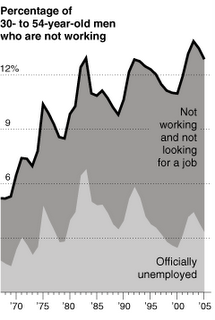Men Not Working, and Not Wanting Just Any Job
About 13 percent of American men in this age group (30-55) are not working, up from 5 percent in the late 1960’s. The difference represents 4 million men who would be working today if the employment rate had remained where it was in the 1950’s and 60’s.That is amazing. I had no idea that it had gone up that much.
The jobless rate is now a low 4.6 percent, yet that number excludes most of the missing men, because they have stopped looking for work and are therefore not considered officially unemployed. That makes the unemployment rate a far less useful measure of the country’s well-being than it once was.
And what about the ladies?
Today, about 73 percent of women between 30 and 54 have a job, compared with 45 percent in the mid-1960’s, according to an analysis of Census data by researchers at Queens College.Looks like they have more than made up the slack.
So why are the men leaving the workforce? I didn't come away with a complete answer, but it appears it has partly to do with less job security and less of a desire to take a lower paying job after losing a job. It also has to do with the fact that more men were in jail.
Hundreds of thousands of young men were jailed in the 1980’s and 1990’s, in a surge of convictions for drug-related crimes. As prisoners, they were not counted in the employment data; as ex-prisoners they are. They are now being freed in their 30’s and 40’s and are struggling to be hired.And it appears another reason is because they can pull it off financially. Wives are picking up the slack, houses are being refinanced and government welfare is being used.
Roughly two million men in this group have prison records, according to a calculation by Richard Freeman and Harry J. Holzer, labor economists at Harvard and the Urban Institute, respectively.
But the fastest growing source of help is a patchwork system of government support, the main one being federal disability insurance, which is financed by Social Security payroll taxes. The disability stipends range up to $1,000 a month and, after the first two years, Medicare kicks in, giving access to health insurance that for many missing men no longer comes with the low-wage jobs available to them.I am not sure what the impact of this is on the economy and society in general, but the trend is definitely going in a bad direction.
No federal entitlement program is growing as quickly, with more than 6.5 million men and women now receiving monthly disability payments, up from 3 million in 1990. About 25 percent of the missing men are collecting this insurance.
via The New York Times
Update: Just read this article, and it states:
From August 1996 to June 2005, the number of people on welfare dropped from 12.2 million to 4.5 million.So there are now more people on social security disability than there are on welfare. Wow!






No comments:
Post a Comment
Note: Only a member of this blog may post a comment.